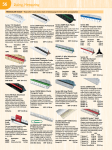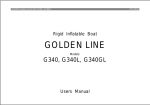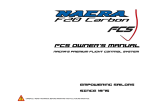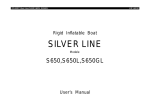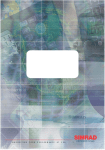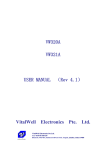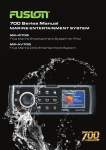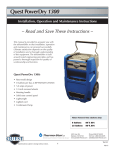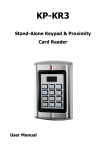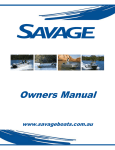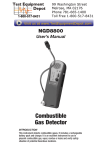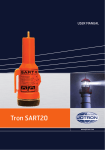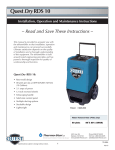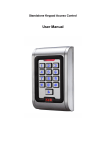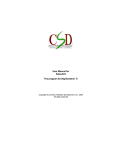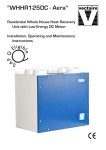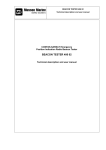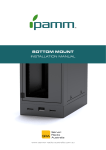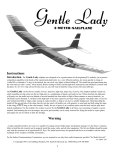Download Safe boat sample pages
Transcript
1.4 Seaworthiness of the vessel Five key considerations of seaworthiness are: • Physical condition of the boat • Boat suitability and propulsion • Vessel stability and freeboard • Attachment of builders plates or capacity labels • Compliance with safety equipment regulations Sample Physical condition of the boat Sa • Before operating any switches or engines, check for petrol and or liquid petroleum gas (LPG) odours. If such odours exist, fix the fault before you go out. • Inspect the bilges. If there is more bilge water than normal, find and fix the leak. When pumping bilges be aware of the environment as polluting the waterways is an offence. Use marine absorbent pads, double bag and dispose of it in the garbage bin. • Also check that you have the bungs in before you go out and keep bilges dry and the self draining holes clear of rubbish, sand or grit from your last trip. Other examples have been discussed in Section 1.3 on predeparture checks. mp le Boat suitability and propulsion Type of motor • Hulls are designed for the type of propulsion required and the motor power and weight on as vessel should never exceed the manufacturers design. Bob Moffatt For example, it is important to make sure that no cracks or damage have occurred since your last boat trip. A careful inspection of the hull and fittings will determine if repairs are necessary. CHECK THE HULL FOR DAMAGE • The easiest way to check this is to look at the builders plate or consult with an authorised marine surveyor. Area of operation • Some hulls are more suitable for bar crossings while some give great fishing stability. Deep V hulls and catamarans shown in the photographs below are suitable for bar crossings. Others like shallow and moderate V's suit estuaries. Your dealer can advise you on which one suits you. pag es Vessel stability and freeboard • Freeboard is the distance between the lowest point of the main deck and the waterline and is an important consideration in the stability of the vessel. Sample Deep V Moderate V Shallow V Twin engine Displacement Rigid inflatable Punt Catamaran Tri hull CHECK THE SUITABILITY OF THE BOAT FOR ITS AREA OF OPERATION Note: This rigid inflatable, deep and moderate V vessels shown above require registration. Bob Moffatt and Telwater Sample Centre of gravity and stability Proper loading and stability mp Sample Displaced water pushes up • When preparing for a trip, the skipper is responsible for assessing the load on board - both people and cargo, to maintain stability. - Heavy items should be stowed in a low and central place where they cannot move around. - Weight, including passengers, should be distributed evenly through the boat. Passengers who are also heavier than normal (ie 80 kg) should be positioned to avoid flooding over the transom. - The weight of extra fuel, water and provisions should be accounted for and if you experience rough conditions, secure the cargo. le Sample When you move around a boat the centre of gravity changes pag Kerry Kitzelman and Bob Moffatt Sa Weight of the boat pushes down Kerry Kitzelman and Bob Moffatt • A boat floats because the weight of water displaced pushing up is greater than the weight of the boat pushing down as shown in the figure opposite. However a boat can sink easily if its not stable. • So a boat must have "positive stability" to be seaworthy. • When you move around a boat, the centre of gravity changes. - Notice how the arrows do not line up in the illustration to the right and if the centre of gravity is lower than the centre of buoyancy, the boat can tip allowing water to flood in. - Also when getting into a small boat, try to step into the center and keep "one hand for yourself and one for the boat." Notice the arrows do not line up es STABILITY AND LOADING Stability also means that there has to be enough freeboard to give the boat time to recover from sideways movement as it moves through the water. - The overloaded tinny shown opposite would have little time to recover and is at risk of flooding. - To enhance the problem of instability, the freeboard in many "tinnies", is measured from the top of the cut out section of the transom decreasing the freeboard even further. Kerry Kitzelman and Bob Moffatt Sample STABILITY AND CENTRE OF GRAVITY Sample ✗ Free surface effect • The free surface effect is one of several mechanisms which can cause a craft to become unstable and roll over (capsize). It refers to the tendency of liquids to slosh about in the vessel and becomes more significant in larger vessels. Lowest point of main deck on transom Wet Paper TMR TMR If the centre of gravity is lower than the centre of buoyancy, guess what happens Attachment of builders plates or capacity labels Capacity label Bob Moffatt Stowage of all heavy items, positioning of passengers on board and water in the bilges all affect stability and freeboard. But how does a skipper know how much cargo and many people he or she can put in the boat? • A capacity label is designed to tell the skipper how many people and cargo the vessel can carry safely. • The label is fixed next to the helm as shown in the photograph opposite. - If the boat goes into exposed waters or rough conditions, as a general rule, the operator needs to reduce the number of people on board by one-third to increase stability. - Labels are available for boats under and over 6m as well as powerboats with a flybridge. - Capacity labels are also required on a personal watercraft. le Buoyancy Builders plates also describe the buoyancy flotation of the vessel if the verssel is swamped or capsizes as shown opposite. • Basic flotation: The boat will remain afloat either by the bow or upside down. - This allows passengers to stay with the boat till help arrives and may provide some shelter and more time to activate emergency procedures. • Level flotation: The boat will remain in a level position as shown in the figure on the right. - The advantage of level flotation is that it provides the opportunity to bail water out of the boat. This is why a bucket with a safety lanyard is recommended as part of safety equipment. • Inadequate flotation - A boat with no flotation sinks quickly. Inbuilt buoyancy • Many smaller boats have built in buoyancy and are said to have positive flotation. • Boats can get a positive flotation statement from an authorised marine surveyor or boat manufacturer. This can affect the requirement for boats to carry PFD's in smooth waters. pag CHECK THE BUILDERS PLATE or check with an authorised marine surveyor Basic flotation es Sample Level flotation Sample No flotation * Note on old builders plates As the average size for passengers is now 80kg. Owners of old builder’s plates should compensate for this in load calculations. LABELS AT THE HELM MUST INFORM THE OPERATOR ABOUT LOADING AND BUOYANCY Kerry Kitzelman mp • All new recreational vessels manufactured or imported into Queensland since September 2006 are required to show an Australian Builders Plate (ABP) built to Australian Standard AS 17991 or other equivalent standard. • If the builders plate is not visible to the helmsman, the capacity label should be displayed near the boat's helm where it can be seen by the operator. However alteration to the boat's hull or permanent fittings may invalidate the particulars on the plate and the recommended persons and maximum load should be reduced in bad weather or when the boat is operating offshore. • If the vessel has an ABP where it can be clearly seen from the steering position, a capacity label is not required. Kerry Kitzelman Builders plates Kerry Kitzelman Sa Life jackets/personal flotation devices (PFDs) mp le For use in smooth, partially smooth and open waters • To comply with Australian Standard 4758 it must be marked ‘Level 100’, ‘Level 150’ or ‘Level 275’. • To comply with Australian Standard 1512– 1996 it must be marked ‘PFD type 1’. • Not to be used by personal watercraft (PWC) riders, skiers or people being towed. Level 100, 150 or 275 Example of 1996 AS 1512 label Under standard AS 4758 Under previous standards Level 275 Level 150 Coastal life jacket Level 275 Level 150 Level 100 PFD type 1 (AS 1512-1996) pag Level 50 PFD type 2 (AS 1499-1996) Level 50 special purpose PFD type 3 (AS 2260-1996) es Note: The levels stands for newtons of buoyancy (N) and is the amount of force or upthrust provided by a life jacket in water Wet Paper • For a life jacket to comply with a particular standard, certain information required under that standard must be displayed. • The current standard for life jackets is Australian Standard 4758 (AS 4758). This standard has replaced Australian Standard 1512– 1996, Australian Standard 1499–1996 and Australian Standard 2260–1996. • You do not have to upgrade your current life jacket under the old standards – they will still be acceptable for use as long as they are in good condition. AS 4758 has a different rating system than the previous standards. Example of 2008 AS 4758 label STANDARDS AND LOGOS Level PFD type, model identification Intended mass range Sample Illustrated donning instructions Standards symbol Instructions for care and storage Manufacturer's name, date of manufacture, batch number CONSIDERATIONS WHEN SELECTING A PFD Bob Moffatt Sa Life jackets/PFDs must comply with standards Life jackets should be marked correctly to ensure they comply with standards. Sample Bob Moffatt • Life jackets should be accessible at all times; if they aren’t visible to passengers you must clearly sign where life jackets are stowed. The sign must have the words ‘life jacket’ in red text on a white background or white text on a red background. - They must be kept in good condition. - They must fit the wearer – ill-fitting life jackets won’t meet the safety equipment requirement. - Do not use life jackets as a cushion. - Make sure you know how to put them on quickly. AMSA Here are some important points to remember about life jackets to avoid getting a fine. Before launching mp Bob Moffatt • Check inside and under the hull to make sure there are no cracks and excessive wear and tear on the craft, including water leaks. • Secure bungs. • Check steering and throttle for correct operation. • Check battery fluid level and charge condition. • Check if there is adequate fuel and oil for usage. • Check spark plugs and electrical systems for evidence of wear and tear or potential for electrical sparks. • Ensure that the intake grate is free of foreign objects. • Ensure all compartments are secure. • Check with the manufacturer’s user manual to find out if they advise starting the engine before the PWC is launched into the water, and for how long the engine should run. le • Cruising PWC (sit-astride): The most popular type, accommodating up to four people. Propulsion PWCs can use either a two-stroke (similar to many outboard motors) or a four-stroke engine (similar to a car engine). Fuel The engine drives a powerful water pump which sucks up water from the bottom of the craft through an intake grate. The water passes through an impeller, a type of propeller fitted into a surrounding “tunnel”, which pressurises the water and forces it out a jet nozzle (below) at the rear of the craft. This jet of pressurised water propels and steers the craft when the throttle is engaged. • Some newer PWC include ‘off-throttle steering technology’ which offers the craft limited manoeuvrability when the throttle is off. • Technology is rapidly changing with a new reversing bucket which is claimed to actually act as a brake. pag • Where possible, fuel your PWC on land rather than on the water to minimise the risk of polluting the waterways and to ensure the PWC is stable. - Be responsible by regularly maintaining your fuel system, not overfilling your fuel tank watching the breathers and using absorbent material to collect fuel overflow. - Be sure to refuel in an open ventilated area where there are no naked flames. Do not over-tighten the fuel cap. es Safety equipment Sample Steering nozzel Bob Moffatt Bung 6.3 Pre-departure checks Routine maintenance • Like any other boat, before taking your PWC out on the water read and understand the owner’s manual. Take the time to become familiar with all aspects of your craft. • Check your operation manual carefully on how to flush your motor as models can vary. • Leave the storage compartment with the seat up to allow for ventilation. • Use protective lubricants to prevent corrosion and don't forget the trailer and its regular maintenance, eg bearings, lights, winch and straps. • In the event of breakdown, PWCs have no alternative propulsion such as oars or sail. It is therefore critical to inspect and maintain the craft to minimise the risk of engine or steering failure. See manufacturers handbook maintenance schedule. Lanyard • PWC's have either an ignition safety switch or a self-circling feature if the operator falls off. • Most cruising PWC come equipped with an emergency ignition safety switch. This is a safety device which is designed to shut the engine down if the Kill switch operator is thrown from the proper operating position. Sample Attached to PFD offatt Reverse bucket • PWC operators and passengers must wear a PFD at all times. The type of PFD and other safety equipment for PWC is dependent on where you are travelling. The table, on the next page, outlines the minimum equipment requirement set by legislation and recommended equipment to satisfy the general safety obligation. • Water limit maps starting on page 26 indicate the three designated water types along the Queensland coast. Consider your entire trip, including areas through which you are only traversing when equipping your PWC. See pages 20 - 21 for a description of PFD types 2 and 3. A Ride Smart sticker must be affixed to the PWC and visible to the operator at all times. Carry the minimum safety equipment, but to enhance safety, confidence and enjoyment consider carrying safety equipment to cater for the unexpected. For example, consider the following equipment: tow rope, spare bungs, spare lanyard, helmet, gloves and booties. Bob M Sa Cruising PWC Lanyard Safe Boating in Qld Workbook 3th Edition MSQ Syllabus match Subject matter, suggested learning experiences and assessment criteria as per January 2012 Competency Standard Unit Learning experiences Page Assessment criteria Unit 1 Trip Planning Understand the important aspects of safety equipment and maintenance. 3-29 Understand the important aspects of safety equipment andmaintenance. Identify the main parts of a recreational vessel and its equipment. Explain the importance of maintenance to vessel safety. List the safety equipment required. Determine the serviceability of safety equipment. Understand the law as it relates to carrying safety equipment and the legal obligations of the ship’s master. Understand the law as it relates to carrying safety equipment and the legal obligations of the ship’s master. Identify suitable PFDs and their location aboard. Understand the obligations of operating a recreational ship in Queensland. Determine if the vessel is fitted in accordance with the provisions of the International Regulations for Preventing Collisions at Sea. Ensure the vessel is seaworthy and suitably equipped for a trip. Ensure the vessel is seaworthy and suitably equipped for its intended operation. Inspect vessel for seaworthiness. List the tools, spares and equipment required for the vessel for its intended operation. Calculate the fuel required for a particular trip. Inspect the ships battery for useability. Unit 2 Navigation Apply IALA Buoyage system ‘A’ and use aids to navigation not covered by IALA. 31-47 Knowledge of the following buoys, marks and beacons and how this is applied to safe navigation. Lateral and cardinal marks. Isolated danger marks. Special marks. Safe water marks. Middle channel marks. Leads. Speed signs. Cable crossings. Recognition of lights used for navigation at night and how these are identified on a chart. Problems associated with lights at night in a metropolitan area. Use a GPS navigation system. Identify and apply collision and water traffic regulations relevant to the activity area. Use a GPS navigation system. Report incidents. Briefly describe how the GPS system works. Operate a chart plotter and determine position. Describe the limitations of a GPS installation. Avoid pollution. Unit 3 Weather and tides Access and interpret weather information. Understand the IALA Buoyage system ‘A’ and use aids to navigation not covered by IALA. 48-53 Access and interpret weather information. Locate up to date weather charts and forecasts from a variety of sources.Interpret the information on a chart and compare to the published forecast.Predict the likely local conditions based on the forecast and local geography. Interpret tide tables. Interpret tide tables. Distinguish between a tide and a tidal stream.Interpret a set of tide tables for a standard port to determine the high and low tides. Estimate the tide height and strength of flow at different times between high and low tide using the law of 12ths. Explain how tidal flow affects handling of small boats and anchoring requirements. Determine the time of high and low tide at a secondary port. Understand the effects of pollution on the marine environment. Unit 4 Emergencies Define and report a marine incident. Respond to a fire on board. Understand the importance of an EPIRB. Use appropriate emergency radio calls. 55-59 Define and report a marine incident. Describe a marine incident is defined in the Act (s123) and what it means.List the obligations on ships’ masters when a collision occurs (s124)Recall that a report must be made, to whom and by when (s125)Explain the seriousness of marine incidents and the importance of reporting them. Respond to a fire on board. List the causes of fire on a small ship. Things to reduce risk of fire. Recall what to do when you abandon ship. Understand the importance of an EPIRB. Describe the features of a functioning EPIRB. Activate a dummy EPIRB. Use appropriate emergency radio calls. Recall the radio frequency to use. Simulate a Securité call. Simulate a Pan Pan call.Simulate a Mayday call. Personal water craft is discussed on pages 67-72 Safe Boating Workbook 3rd Edition QSA Syllabus match Subject matter and suggested learning experiences Key concepts / elaboration Learning experiences Page KU MS1.1 Regulatory requirements and procedures are essential for dealing with hazards, accidents and emergencies. Explain the general safety obligations (GSO) of operating a recreational ship in Queensland. Determine if the vessel is fitted in accordance with the provisions of the International Regulations for Preventing Collisions at Sea. Identify suitable PFD’s and their location aboard. Evaluate and communicate emergency plans for a day’s scientific research. 3-7 MS1.2 Risk assessments are carried out before conducting investigations in the the field. Explain hazards, risks and control measures for all water safety skills. Estimate risks for launch a boat. Inspect the ships battery for hazards. Identify correct loading of a vessel to maintain stability. Determine risks at the boat ramp and while operating the vessel. Determine risks when towing plankton net, operating current drogue, collecting water samples from depths, using probes in the boat. Moving around a boat while operating science equipment. Evaluate and communicate risk levels to crew. 60-66 MS1.3 Water safety skills and first aid procedures are important when undertaking marine activities. Conduct a passenger briefing to satisfy GSO compliance. Tie a bowline in a length of rope to secure scientific equipment to a vessel. 60-66 Review basic boating skills: Mount an outboard motor and safety depart and return to a beach. Safely engage and disengage forward and reverse gears. Manoeuvre the vessel at slow speed to determine its steering characteristics at low speed. Anchor the vessel ensuring the correct amount of anchor rope is deployed. Verification of anchor set is made with reference to landmarks ashore. Create a towing bridle and tow a plankton net. 60-66 Review emergency procedures: Perform an emergency stop and review procedures for loss or snagging of science equipment. Approach a man overboard (MOB) with regard to wind and tide to retrieve. Perform basic first aid resuscitation skills. 60-66 MS1.5 Weather forecasts and synoptic charts are interpreted prior to and during investigations with decisions being made according to changing weather conditions. Locate up to date weather charts and forecasts from a variety of sources. Interpret the information on a chart and compare to the published forecast. Predict the likely local conditions based on the forecast and local geography. Discuss effects on passage planning. Evaluate and communicate a passage plan. 48-49 MS1.6 Safety equipment is used and maintained. Explain the importance of maintenance to vessel safety. List the safety equipment required for area of operation. Determine the serviceability of safety equipment. 16-29 MS2.2 Operating a vessel safely in different conditions and maintaining and servicing boat parts and accessories is a component of marine research. Manoeuvre the vessel at slow speed to approach and reverse away from a mooring, pontoon or jetty. Use reverse gear to slowly move away from the mooring. Smoothly apply power to get the vessel to plane. Perform turns at speed to port and starboard. Use motor trim to maximise engine performance especially when towing science equipment. Calculate the fuel required for a science field trip. 60-62 Inspect vessel for seaworthiness. List the tools, spares and equipment required for the vessel for its intended operation. Inspect the ships battery for useability. Complete pre-departure checks. Explain boat maintenance and service schedules. 15-16 MS2.3 Boat design, including hulls, materials and methods of propulsion, should suit the area and purpose of operation. Identify the main parts of a recreational vessel and its equipment. Interpret a Capacity Plate or Australian Builders Plate. Recognise the key components of a steering system. Identify different hull shapes and their handling characteristics. Review advantages and disadvantages of different engine and drive types. 7-12 OC2.5 Tidal movement is driven by the gravitational pull of both the moon and sun, influencing current strength and wave action. Distinguish between a tide and a tidal stream. Interpret a set of tide tables for a standard port to determine the high and low tides. Estimate the tide height and strength of flow at different times between high and low tide using the law of 12 th’s. Explain how tidal flow affects handling of small boats and anchoring requirements. Determine the time of high and low tide at a secondary port. 50-52 18-26 IA EC Key concepts / elaboration Learning experiences Page KU MS3.1 Marine navigation and communication devices and procedures are used for coordination and safety. Calculate a course allowing for variation. Evaluate effects of tidal heights and streams (where applicable) Discuss high speed navigation techniques Use a GPS or Chart Plotter as an aid to navigation and be aware of the limitations when using electronic charts Recognise distress signals and obligations. Discuss types of on-board emergencies and actions. Operate a marine radio in distress situations (simulate) 43-46 MS3.2 Chart datum and the IALA-A (International Association of Lighthouse Authorities region A) buoyage system are interpreted when operating vessels in marine environments. Describe the following buoys, marks and beacons and how this is applied to safe navigation. Lateral and cardinal marks; Isolated danger marks; Special marks; Safe water marks; Middle channel marks; Leads; Speed signs; Cable crossings. Recognition of lights used for navigation at night and how these are identified on a chart. Problems associated with lights at night in a metropolitan area. 39-47 MS3.3 Navigational aids, including compass, GPS, and charts are used to plot courses Describe how the GPS system works. Operate a chart plotter and determine position. Describe the limitations of a GPS installation. 44-46 MS3.4 A safe passage is planned and implemented using a variety of calculations and modifications (e.g. speed, distance, time). Plan a passage with consideration of weather, crew and vessel capabilities. Can undertake a short passage by day or night incorporating navigation and rules of the road 45 MS3.5 Radio transmission communication should be clear and concise and fitting to local regulatory requirements Describe log on and log off procedures, radio checks with local VMT Coast Guard. Recognise silence periods and local radio protocols. Communicate radio logo/log off, radio checks. Simulate a Securité call. Simulate a Pan Pan call. Simulate a Mayday call. 59 MS3.6 Organisations play vital roles in search and rescue Recall the radio frequency to use. 59 55-59 IA EC








